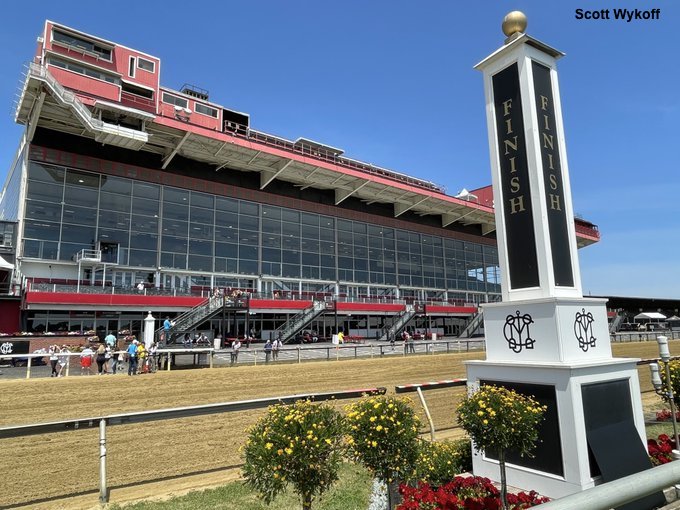
Photo of Pimlco Race Course’s iconic grandstand by Scott Wykoff
Maryland Governor’s pending signature will solidifying the Pimlico Plus Plan
By Maribeth Kalinich
Maryland Governor Wes Moore (D) could change the course of Maryland Thoroughbred horse racing and the future of Pimlico with the stroke of his pen.
Moore has not signed HB 1524 or HB 1416. He has three more official signing sessions and then will have until the effective date of the legislation to sign, veto or do nothing which makes it law.
The latter method was how the 2020 bill, the Racing and Community Development Act, became law as then Governor Larry Hogan preferred not to put pen to paper.
HB1524 could become law on June 1, 2024, and the torch of ownership of historic Pimlico Race Course will be passed from The Stronach Group to the State of Maryland.
Referred to as the “Pimlico Plus Plan,” the bill allots $400 million in bonds funding to be facilitated by the Maryland Stadium Authority.
One sticking point with the legislators was the housing described for track workers in the bill. There are no dorms noted on the site plans and the plan is to house most or all workers off-site in redevelop housing in the surrounding community.
Another rather prickly point was the proposed manner in which to pay the debt service on the bonds. $17 million per year from a Racetrack Facility Redevelopment Account/Fund (RFRA/RFRF) money that is currently going to Rosecroft Raceway was earmarked for this debt service. The caveat is that Rosecroft needs to close in order for this money to be available.
Rosecroft is currently under the ownership of TSG.
With too many questions unanswered regarding this, the Standardbred Breeders and Owners of Maryland stepped forward with objections noting several relevant points.
One, Rosecroft is still open. Two, the money should revert to the other Standardbred facility, Ocean Downs, owned by Churchill Downs Inc. (CDI) that will need to absorb the industry with major improvements such as winterization as they are a resort track with meets in the warm months.
Amendments added to the bill included new language that would replenish a capital-improvements fund for Rosecroft. The new language will still allow the operating company to use the funds for improvements, but the state has agreed to replenish the fund in 2026.
Once this was corrected and amended in the bill, it passed favorably out of the House for the final time to go to the Governor.
The debt service on the bonds was originally proposed in 2020 to be covered by money out of the purse fund ($5M) as well as the Racetrack Capital Improvement fund ($8.5M) with City Infrastructure ($3.5M), all generated by slots/Video Lottery Terminals (VLTs).
To kick off this fast-tracked bill, the Ways & Means Committee approval was key. It moved favorable through that committee by a vote of 18-4 with one excused. Also requiring a favorable response from the Budget and Taxation Committee, the legislation moved forward unanimously (13 vote) with the amendments.
After amendments were made that included removing the funding that was to be taken from the Standardbred industry for the debt service, HB 1524 passed the Senate and the House by a vote of 104 yeas, 34 nays and two not voting (final vote after third reading 106-31).
Among the other amendments added to the bill on Monday was a provision requiring 10 percent of the operating company’s annual profits to be distributed to local organizations around the Pimlico property. In addition, a provision was attached to the bill requiring the addition of voting members to the operating company’s board who represent the Park Heights Renaissance organization and the local community where the training center is built.
1/ST has agreed to deed Pimlico to the state for the cost of $1. As part of the transfer agreement between 1/ST and the state, 1/ST will receive $3 million each year from the operating company for the rights to the Preakness and Black-Eyed Susan stakes, along with 2.5 percent of the gross wagering on the two days of racing supporting the races. Those payments came under criticism in the final debates over the bill, but supporters of the transfer agreement said that 1/ST would have been unlikely to support the plan without the annual payments.
The Pimlico Plus model has significant economic development benefits for both Baltimore and the community that will house the new training center. These include the creation of jobs and year-round economic activity at both locations, with between 140 and 160 racing days at Pimlico; workforce housing to be constructed in the Park Heights community near the Pimlico site to serve track workers; the creation of a 1,000-seat event space and new hotel at Pimlico; potential for partnerships with workforce development and higher education programs to prepare for jobs and careers in the racing and hospitality industries; and the creation of development parcels adjoining the newly redeveloped Pimlico racetrack.
Approximately $300 million will go to the redevelopment of Pimlico with an additional $100 million to be spent creating a new training facility. To view the MTROA’s Racing & Training Center Report click here.
Working with its consultant, Populous, the Authority identified eight potential locations within a 50-mile radius of Pimlico to be examined for suitability. Those are: Bowie Race Track (Bowie), Fair Hill Training Center (Elkton), Laurel Park (Laurel), Mitchell Farm (Aberdeen), U.S. Naval Academy Dairy Farm (Gambrills), Rosecroft Raceway (Fort Washington), Maryland State Fairgrounds (Timonium), and Shamrock Farm (Woodbine).
The eight sites were reviewed extensively and ranked on a scoring mechanism that evaluated nine criteria: location, natural resources (and impact on permitting/mitigation), topography, transportation and access, utility infrastructure, jurisdictional approvals, size, acquisition cost, and relative cost of development.
Based on those criteria and scoring, the three top-ranking sites are Shamrock Farm, Mitchell Farm and Bowie Race Track, and it is the recommendation and conclusion of the Authority that those three locations move to a next stage for final consideration and subsequent acquisition
The decision will be announced later this year regarding which location will be developed into a state-of-the-art training facility.
Laurel Park will remain open for both racing and training until the Pimlico Plus Plan is completed.
1/ST will retain ownership of Laurel Park, where racing will be held while Pimlico is being rebuilt. 1/ST is expected to sell the Laurel property once racing is transferred to Pimlico, expected to be some time in 2026.
There is no set schedule for the Pimlico redevelopment plans to break ground but it was mentioned it could begin as early as October of 2024.
The Preakness Stakes, that remains under the ownership of The Stronach Group, will be run at Pimlico in 2025 to celebrate the 150th edition of the Spring Classic.
It is unknown what condition the facility will be in for this event.
Racing and the Preakness will move west to Laurel Park for 2026 and is said to be returning to Pimlico in 2027.
It is logical to assume that the majority of the redevelopment will happen after the 2025 Preakness.
The nascent Maryland Thoroughbred Racing Operating Authority (MTROA) is the agency that inspired the legislation with a report submitted to the state Jan. 5, 2024.
The report stated “The combination of a rebuilt Pimlico augmented by an industry-run training center will place Maryland’s $2 billion-per-year horse industry on solid footing and position it to thrive into the 21st century.”
The MTROA is also the agency that will oversee and operate the new Pimlico and the training facility.
The Stronach Group (TSG) as their face company 1/ST will lease Pimlico to run the Preakness annually.
Development of Pimlico while still in the planning stages, is said to include a new clubhouse, a hotel and a parking garage. While two options for the site plan were offered by the MTROA in their report, the tilt is to Option 2, rotating the historic racing oval.
The Pimlico Plus Program
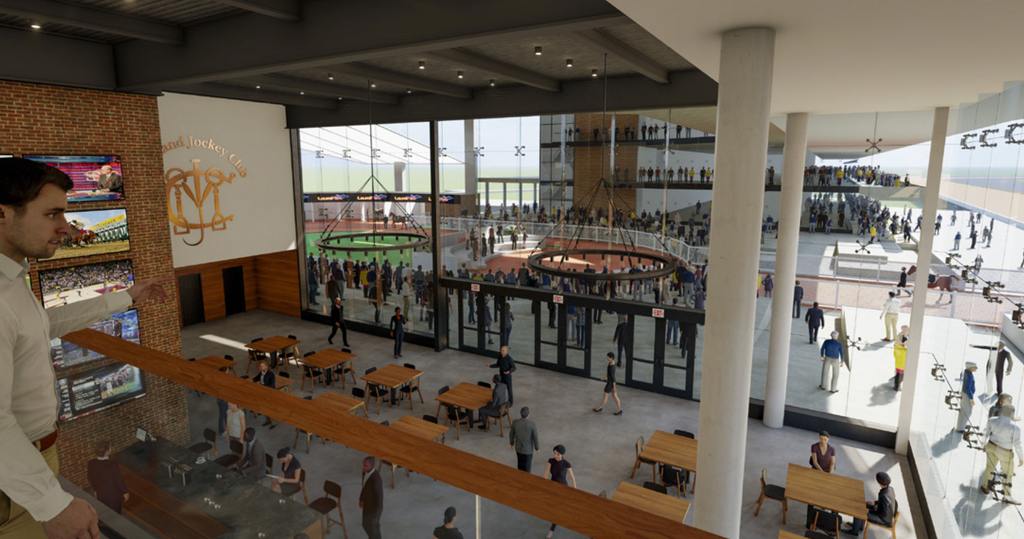
The consultant team revisited the original programming and that created for the 2021 Laurel master plan concept to create the updated program and diagrammatic plans presented here. Some of the key operational spaces that are now incorporated include jockey’s facilities, broadcasting, mutuels/money room, racing administration, media facilities, spaces to accommodate daily live racing patrons, and other spaces.
With all of that said, the diagrams and photos that follow are intended for pricing and utilization. They do not represent architectural plans of what will be built in any way.
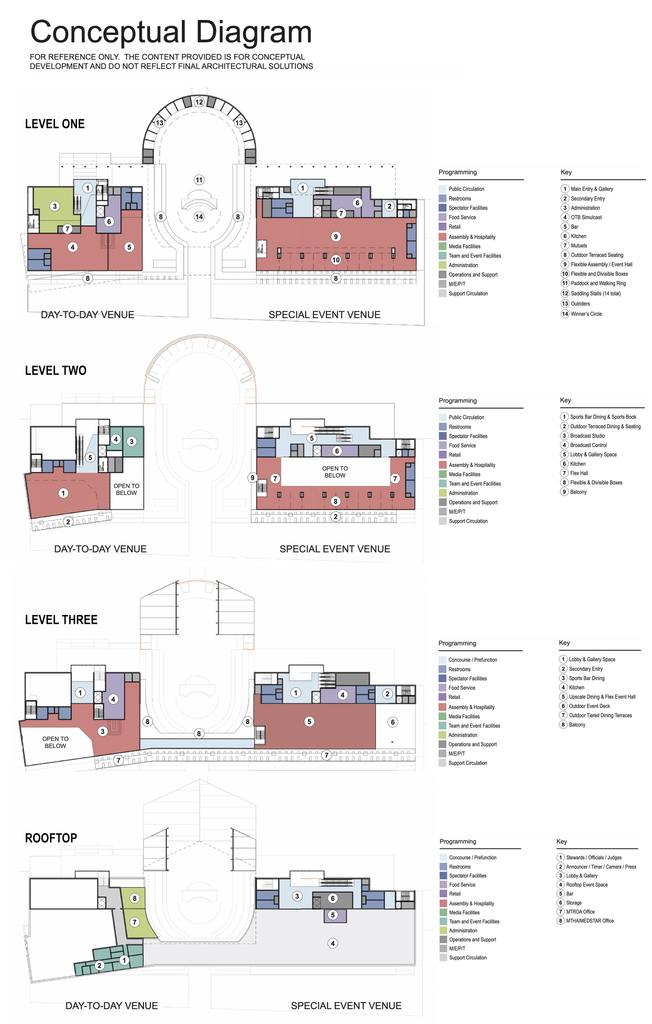
People want to be as close as possible to the scenes and the action in an event, whether it is the finish line, starting gate, the winner’s circle, the paddock and walking ring, or the track. They desire to feel like they have experienced the whole package; as if they participated in the event, in the win or loss.
For the design concept, the Paddock and the Winner’s Circle are a focal point, creating a theater connecting people and horses. The venue straddles the paddock offering two programmed venues at once. The venue offers the capacity to host large and small events including but not limited to large racing events, off track betting, full-service food and beverage, and community and private events. This provides the opportunity to maximize flexibility and revenue streams.
For a large racing event, both sides of the new clubhouse will operate simultaneously as one venue, offering a distinct experience blending the spaces together. For day-to-day operations, only the smaller south side will be activated to minimize staffing and operations costs and providing space availability in the north side to host other revenue- generating events.
The programmed capacity of the new clubhouse is 2,450 indoor and 2,750 outdoor including elevated terraces, terraces around the walking ring and the track apron.
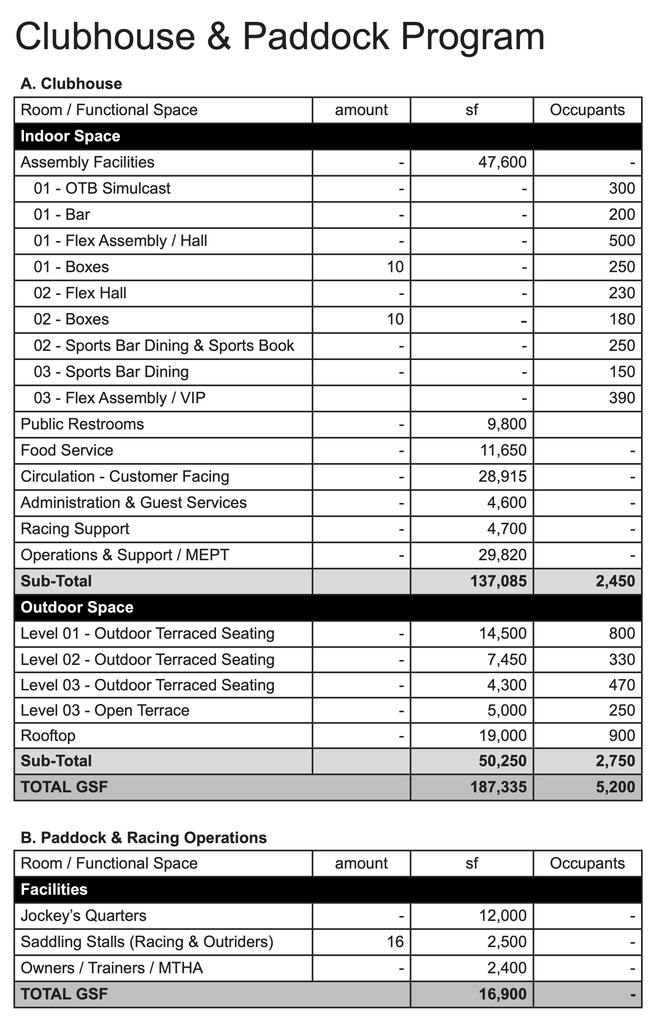
The Clubhouse and Paddock experience will look to curate and incorporate the historical elements from the existing facilities such as the bas relief of ‘The Great Race’, timbers from the Old Grandstand, as well as other sculptures, artwork and murals, and other unique artifacts.
The total estimated costs for Option 1 are $274,888,809 with Option 2 coming at $283,157,826, a difference of over $8 million (8,269,017) if the track is rotated.
The Parking Garage and Workforce Housing are not included in the cost estimates. Those were given separately as Parking Garage (MEDCO Partnership) is estimated at $29,205,000 and approximately $25,000,000 for offsite Workforce Housing (DCHD Partnership) for 150 rooms.
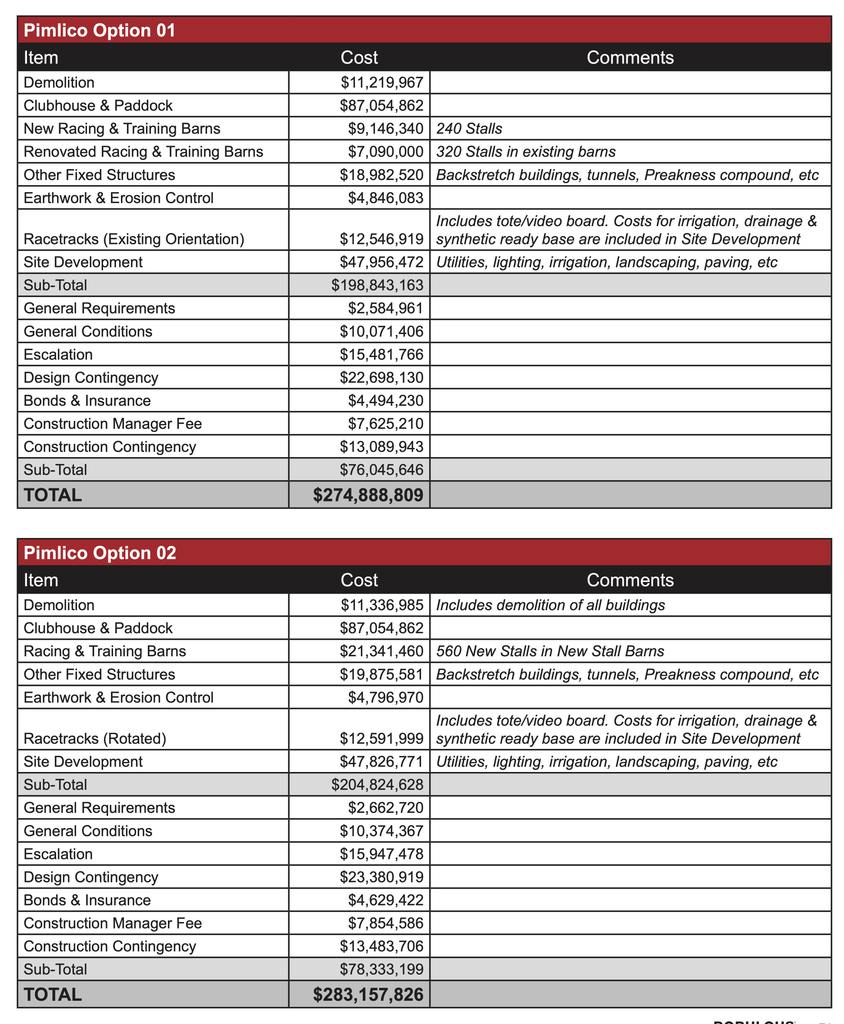
The estimate also did NOT include the following items:
- Architectural Design Fees or other consultant fees.
- Site Acquisition Costs
- Impact or other Government costs.
- Costs resulting from owner requested changes or design changes.
- Utility company charges.
- Rock excavation.
- Any special testing requirements or inspection costs.
- Owner’s commissioning/testing agent/third party services
- Swing space.
- Office/Dining/Bar furniture and equipment.
- Audio/visual devices, wiring, equipment. (rough-ins are included)
- Incoming fiber optics to site
- BGE transformers or primary circuits
- Sports betting equipment/system.
- Broadcasting/video/Scoreboard system & equipment.
- Timing System.
- Parking/event payment systems.
- After hours work.
- Historic preservation.
- Traffic light work.
- Starter equipment.
- Horse equipment (scales, etc.)
- Site Furnishings (benches, trash receptacles, bus shelter)
- Chalet relocation
- Artwork.
As mentioned, two options were offered in the MTROA report. This closely resembled the same options offered by MSA in their 2018 study. To view MSA Study of Pimlico, Phase 2, Part 1 click here.
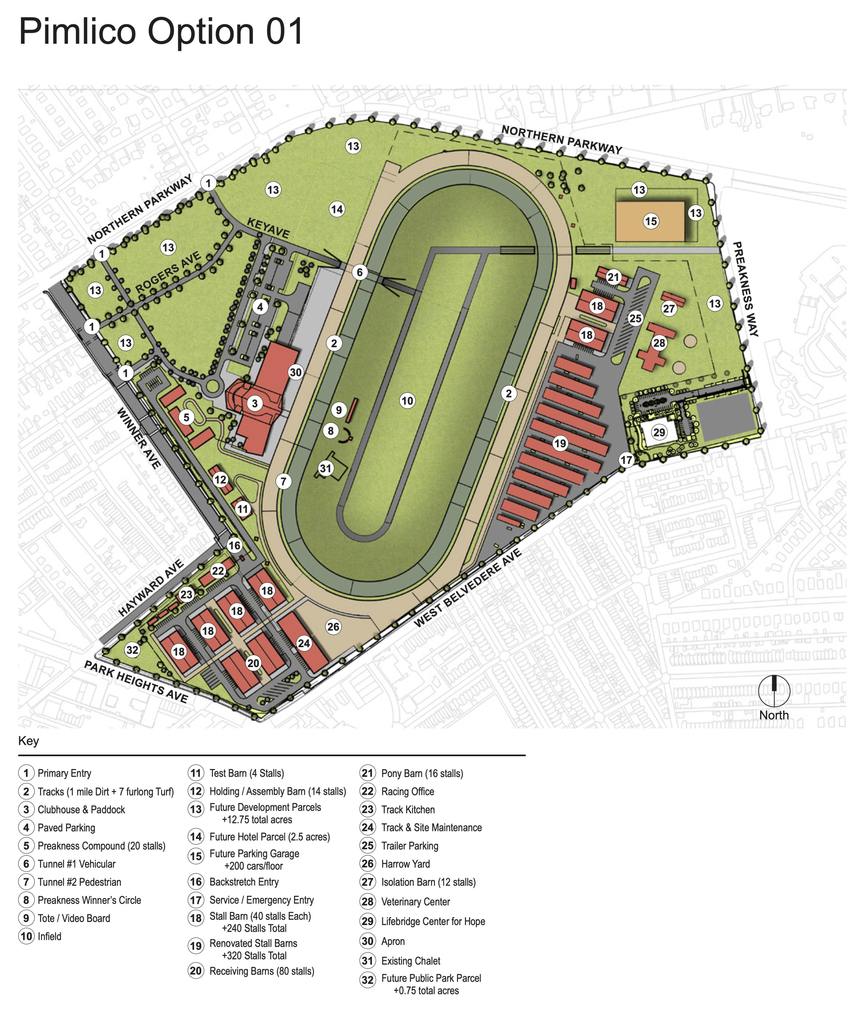
Pimlico Option 01
Two new tracks in EXISTING ORIENTATION
+ 1-mile Dirt and 7/8-mile Turf
+ Consistent 70’ width for entire length
+ Synthetic ready base and drainage infrastructure for the 1-mile dirt track 560 Stalls (Resident Racing & Training)
+ 320 stalls in Renovated Existing Barns
+ 676 Total Stalls including Preakness Compound, Receiving and Pony Barns New 5,200 capacity Clubhouse & Paddock
+ Indoor venues: 2,450 people
+ Outdoor venues: 2,750 people
15.25 acres of Development Parcels
+ 2.5 dedicated for hotel on homestretch
+ Does not include area dedicated for parking garage
Additional considerations:
• Parking Garage
• Public Park Parcel (0.75 acres)
• Worker housing off site
• Equine Wellness Research Center
• Hotel w/ below ground parking
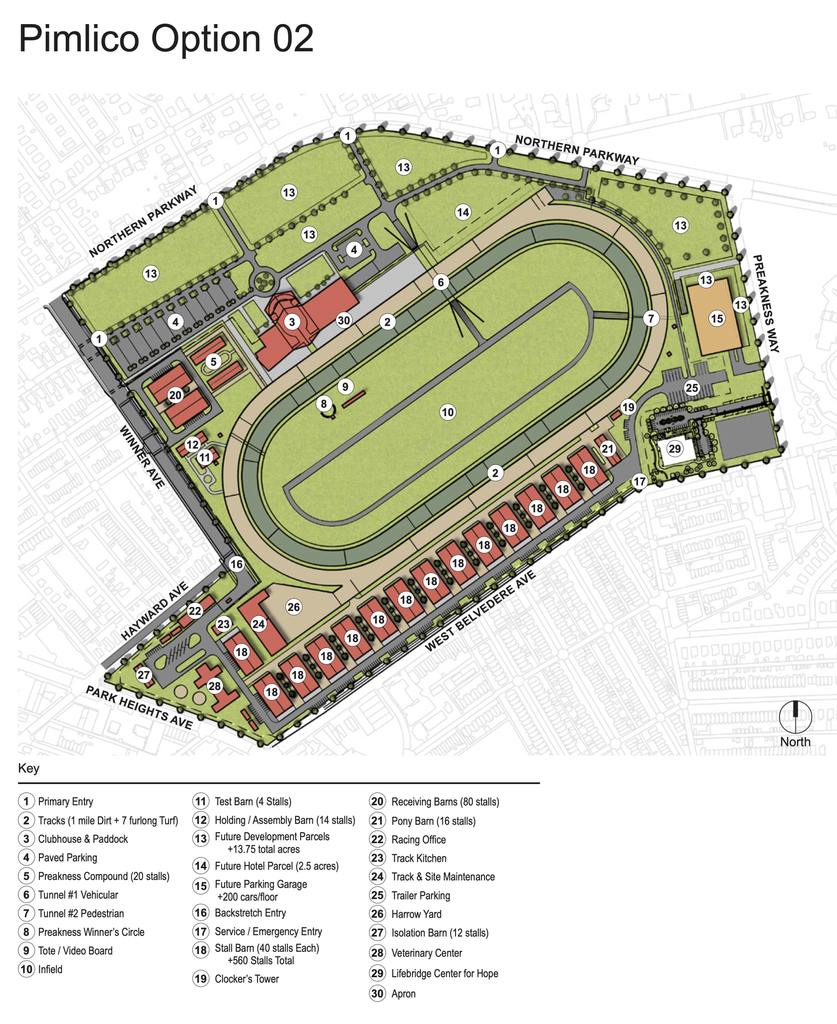
Pimlico Option 02
Option two rotates the track to give room for more “development parcels.”
Two new tracks in ROTATE ORIENTATION
+ 1-mile Dirt and 7/8-mile Turf
+ Consistent 70’ width for entire length
+ Synthetic ready base and drainage infrastructure for the 1-mile dirt track
+ 560 Stalls (Resident Racing & Training)
+ All New Barns
+ 676 Total Stalls including Preakness Compound, Receiving and Pony Barns
16.25 acres of Development Parcels
+ 2.5 dedicated for hotel on homestretch
+ Does not include area dedicated for parking garage
Additional considerations:
• Parking Garage
• Worker housing off site
• Equine Wellness Research Center
• Hotel w/ below ground parking
The total estimated costs for Option 1 are $274,888,809 with Option 2 coming at $283,157,826, a difference of just over $8 million (8,269,017) if the track is rotated.
Option 2 allows for one additional acre for development and costs $8.26 million more than Option 1.
With either option, the Preakness will have a capacity of 71,000 including both permanent and overlay facilities. This is far less than the current capacity for attendance in the past few years.
In 2023, the race course attracted 8% more fans for both Preakness Day and Black-Eyed Susan Day over the previous year, estimated at 65,000 for both days according to a statement from Acting President and General Manager of the Maryland Jockey Club Mike Rogers.
But 8% isn’t much when you consider there were only 60,000 visitors to Old Hilltop in 2022.
The crowd was limited to 10,000 in 2021, though that year saw a record $68.7 million wagered, an amount that included all bets, both from the track and off-site locations.
There were no spectators in 2020 because of COVID-19.
Previous years saw attendance above 100,000. 140,327 attended in 2017 when Chad Brown trainee Cloud Computing took the Woodlawn Vase. When Justify won the second leg of his 2018 Triple Crown 134,497 came out to see the historic event. Attendance dropped in 2019 to an estimated 131,000.
Laurel Park Assessment
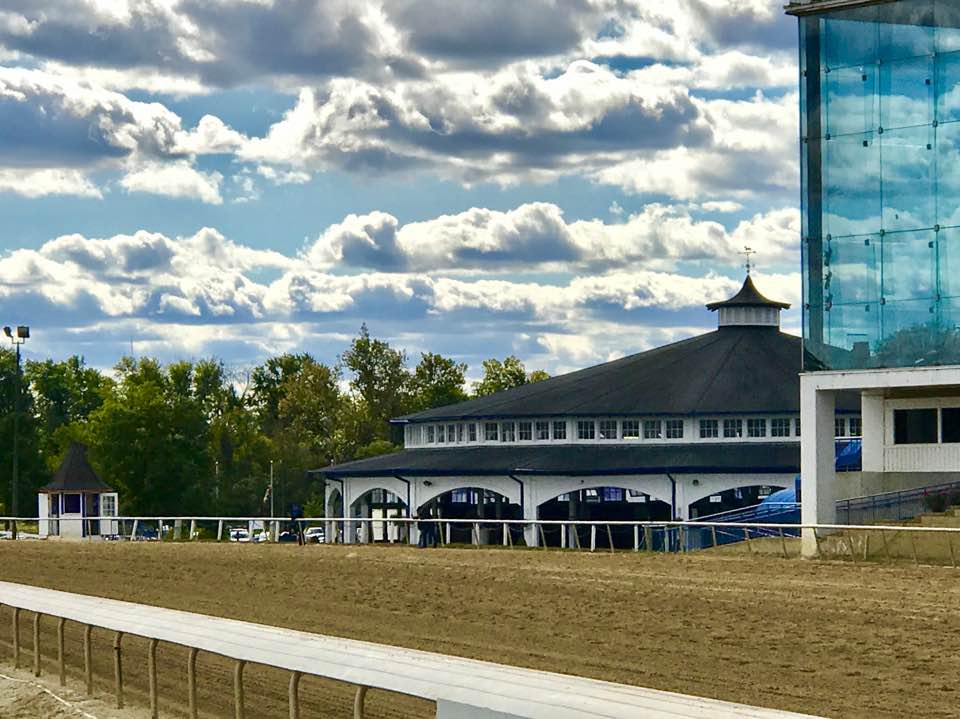
As previously determined in the Maryland Stadium Authority’s 2021 Facility Assessment, a majority of existing barns and backstretch facilities have exceeded their service lives and need to be replaced. Additionally, the Clubhouse and site has a number of outstanding life safety and accessibility violations as well as significant deferred maintenance. During the MSA’s 2021 Programming and Due Diligence efforts, it was also determined that any redevelopment of facilities will require significant stormwater and wetland mitigation. Development is also limited by portions of the site being in the flood plain.
The Laurel Park site as well as adjoining Brock Bridge property has been studied multiple times by various parties in the last decade, and more intensely since 2019 with the 2020 Racing and Community Development Act envisioning relocating the Pimlico horses to Laurel. Scenarios have explored accommodating as many as 1,600 horses on both Race Track and Brock Bridge sites, and up to four racing surfaces. Throughout the 2021 MSA Programming, Due Diligence and Concept Planning it was determined that redevelopment of the Race Track site alone could support just over 1,000 horses.
The Training Facilities
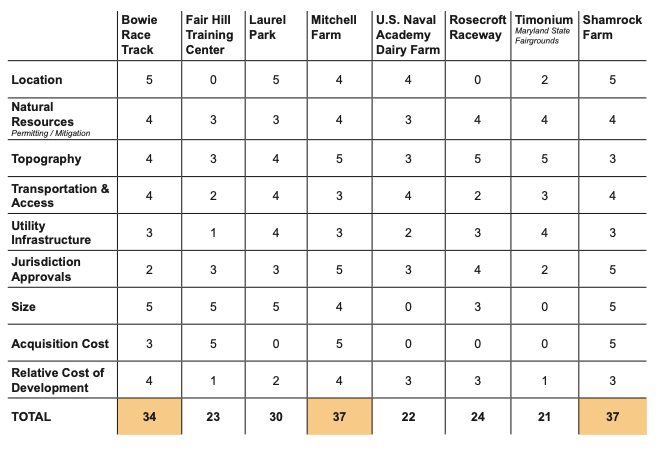
The consultant team developed site plan test fits for the training facilities on the three top scoring candidate sites.
Rosecroft Raceway was studied and determined that it could fit the minimum required Training Center program; however, because of the high cost of acquisition and the long distance from Pimlico, no further concept refinement or site development analysis was pursued. Travel time of over an hour for ship-in to live racing is not acceptable.
Assessing Planning Parity of the three top locations showed the only differences being the size of the property and the Bowie option considered community development in the infield. The Bowie option results in a net horse population of 1,160, which is 40 less than the desired minimum.
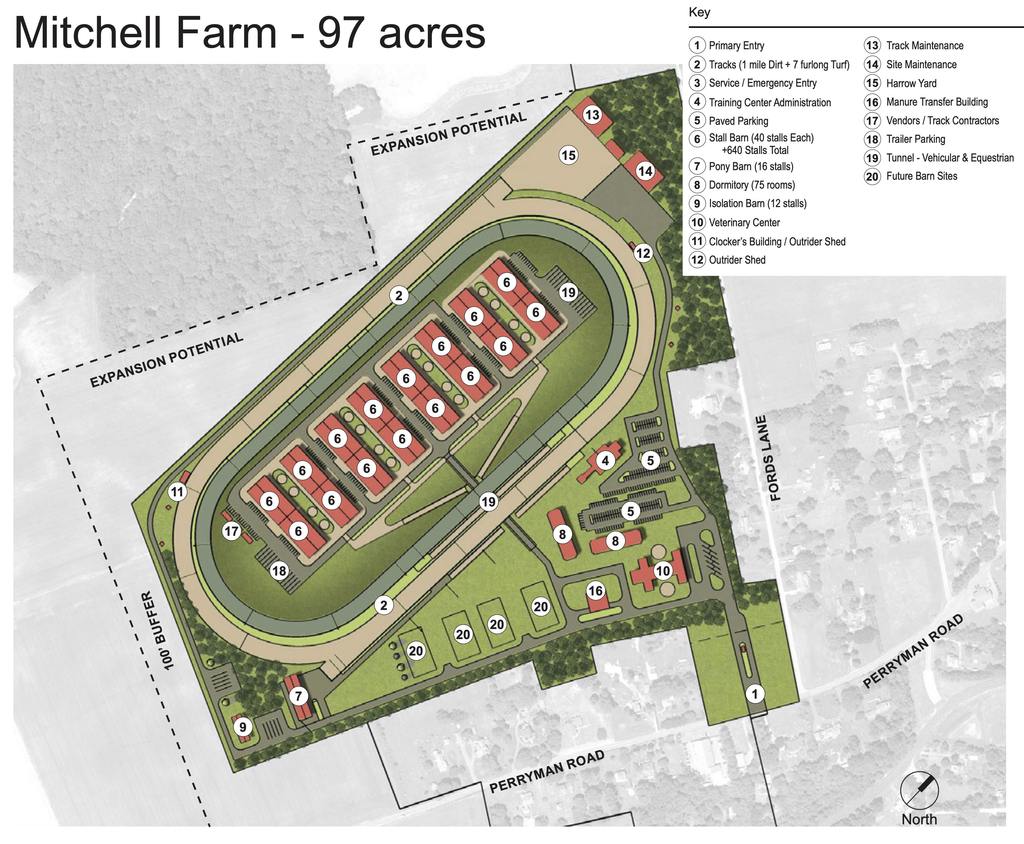
Mitchell Farm Training Center Candidate, near the Aberdeen Proving Ground
• 97-acre site
• Two training tracks
• One Tunnel
• 1-mile Dirt and 7/8-mile Turf
+ Synthetic ready base and drainage infrastructure for the 1-mile dirt track
• 640 Stalls (Resident Racing & Training)
Additional considerations:
• Equine Wellness Research Center
• Dormitories (150 total rooms)
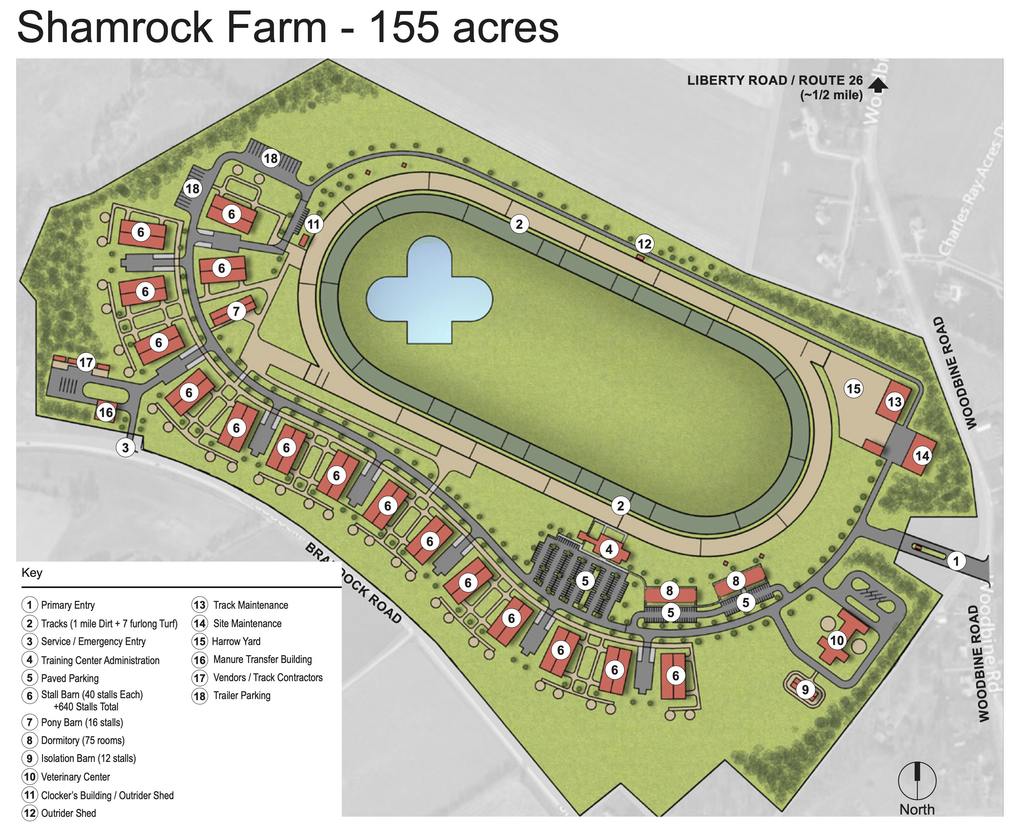
Shamrock Farm Training Center Candidate, near Sykesville, Maryland
• 155-acre site
• Two training tracks
• No tunnels
• 1-mile Dirt and 7/8-mile Turf
+ Synthetic ready base and drainage infrastructure for the 1-mile dirt track
• 640 Stalls (Resident Racing & Training)
Additional considerations:
• Equine Wellness Research Center
• Dormitories (150 total rooms)
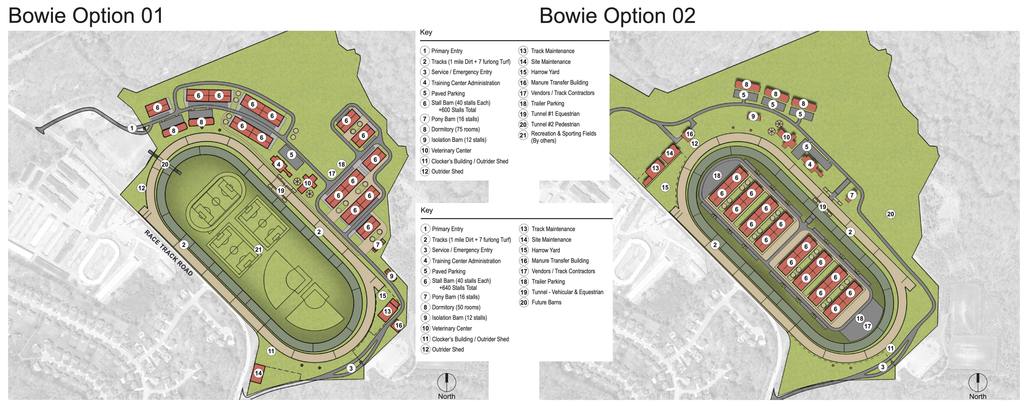
Bowie Option 01 Training Center Candidate
• 131-acre site
• Two training tracks
• Tunnel
+ Pedestrian and Emergency Vehicles for private infield access 1-mile Dirt and 7/8-mile Turf
+ Synthetic ready base and drainage infrastructure for the 1-mile dirt track
• 600 Stalls (Resident Racing & Training)
+ This results in less than 1,200 total stalls
Additional considerations:
• Equine Wellness Research Center
• Dormitories (150 total rooms)
• Infield Recreational Fields
Bowie Option 02 Training Center Candidate
97-acre site
Two training tracks
Two Tunnels
+ Vehicular and Equestrian
1-mile Dirt and 7/8-mile Turf
+ Synthetic ready base and drainage infrastructure for the 1-mile dirt track
• 640 Stalls (Resident Racing & Training)
Additional considerations:
• Equine Wellness Research Center
• Dormitories (150 total rooms)
_________________________




